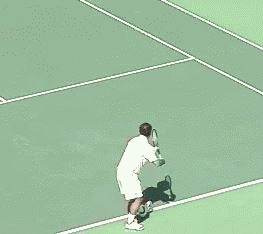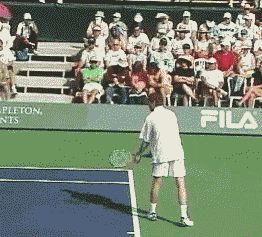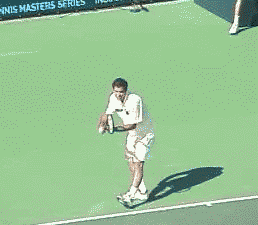|
TennisOne Lessons by Jim McLennan
Studying the serve has become something of a lifelong quest for me. In fact, at the 1987 USPTA national seminar contest I presented "In Search of the Perfect Swing," which was a discussion of issues of racquet speed and momentum as measured by an electromechanical gadget, which has led me deeper and deeper in this search. A good friend and often critic Bill Rapp (who I defeated in this 1987 contest) is prone to point out that I must still be searching for this swing when I drop serve in his presence. Perhaps it is his net play that causes these serving lapses, but that may be another issue entirely. But as regards the actions and interactions that coordinate into a rhythmic powerful and efficient serve, there are components of how the body builds force from the ground, how those forces move up through the body, and how those cumulative forces ultimately release into the racquet as it meets the ball. Cartwheeling refers to how the shoulders move up and into the hit. And just as a cartwheel turns up into a rolling forward (vertical) motion, the shoulders can move in a similar fashion. But before a description, allow me two stories.
1984 Masters Tournament, Stockholm Sweden , John McEnroe vs. Anders Jarryd. At a midpoint in the match, Jarryd holds serve, McEnroe smashes his racquet on the court and goes to his chair on the changeover, not knowing he has totally cracked his racquet. Mac cools down, moves to the baseline for his first serve of the subsequent game, goes through his motion swings up at the ball and .. The head of the racquet separates from the throat and handle and flies at least 40 feet in the air. Really! Where did it land? I have asked this question to many a group of tennis professionals when presenting video material of the famous Pancho Gonzalez serve. Generally, the answer given (though incorrect) is that the head flew across the net and landed in the opponents court. Actually the head flew straight up and landed along McEnroe's baseline. The shoulders had cartwheeled UP and created tremendous upward momentum in the racquet and the soon to be departed racquet head. Second story. On a cover of Tennis magazine, February 2001, Pete Sampras is captured an instant after service contact, in his signature hand up forearm turned in, racquet pointing down position. If you look closely at the cover photo you can actually see a few beads of sweat that are flying UP and off his shirt in the area of his right shoulder. This indicates, I believe, how fast he was able to cartwheel his shoulders up and into the hit. And though all the books indicate the greatest contribution to service racquet speed comes from the inward rotation of the arm and forearm (and I believe this as well) the engine that leads and ultimately enables this forceful endorotation is in fact the shoulders cartwheeling up and into the hit.
So to interpret the service action of Pete Sampras, or Andy Roddick, or Marat Safin (as well as most of the other professionals): the motion begins with a careful toss, and during the toss the player is generally centered and balanced. Then there is a significant "sink" as the knees bend. Note the tossing arm remains up during the sink, and remains up as the knees begin to extend up and into the hit. As pertains to the cartwheel, note how the extended tossing arm tends to lower the hitting shoulder, and this low hitting shoulder in sync with flexed knees, initiates the upward cartwheeling action. If the sink is not low enough, or the server is not centered during the sink, then there will be less force generated by the legs against the ground. If the tossing arm is not well up, or the hitting side not well down, then there will be less distance for this hitting shoulder to build momentum as it cart wheels up and into the hit. And finally, it all gets back to timing. For if the shoulders have cartwheeled up and then the hitting side begins its descent during the hit, power is lost and a netted serve likely results.
And now to try and put the three serving articles together. Power comes from the ground up so it all begins with the legs, the sink after the toss, and how balanced you are as you explode up and into the swing. Then it is about the shoulders, and how they turn up and into the hit. And finally it is about the arm and forearm, and how the elbow extension up (throwing a dart in the ceiling) followed by inward rotation (unscrewing the light bulb) delivers the racquet head into the ball. Interestingly, this action is nearly identical to the biomechanical representations of the badminton clear - an overhead smash designed to drive the opponent as far back as possible - and performed only when the racquet has swung up and into the shuttlecock with no - repeat no - downward snap.
Your comments are welcome. Let us know what you think about Jim McLennan's article by emailing us here at TennisOne.
|
|||||||||||





